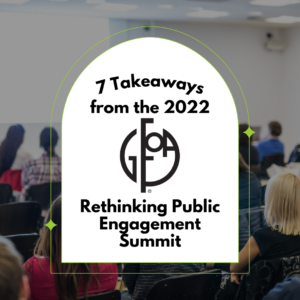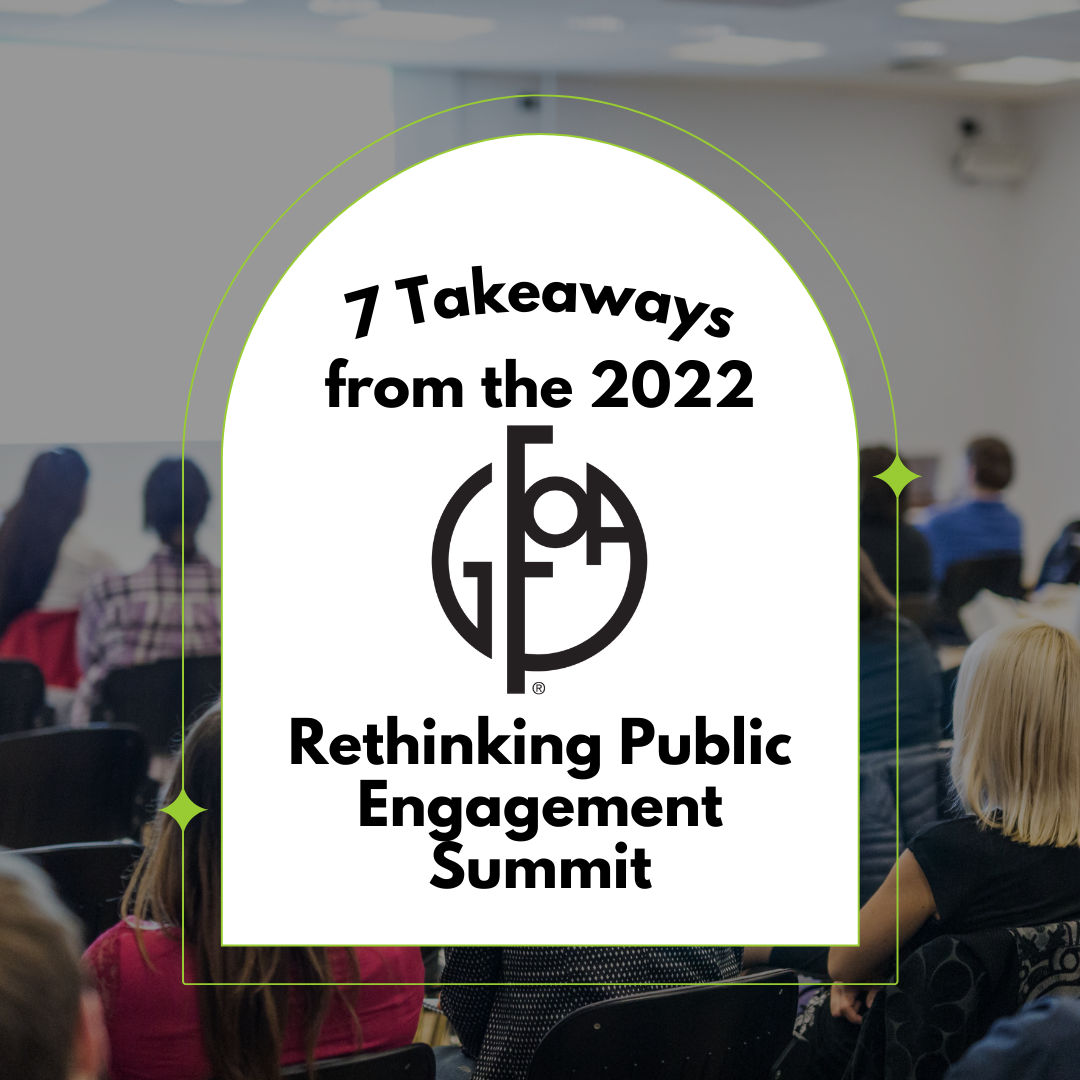7 Takeaways from the 2022 GFOA Rethinking Public Engagement Summit
 In November 2022, the Government Finance Officers Association (GFOA) offered its first “Rethinking Public Engagement Summit.” The virtual summit was part of GFOA’s Rethinking Budgeting initiative and focused on how to reimagine garnering public engagement during the process of creating (and presenting) an annual budget. Especially in the face of public distrust of experts, loss of faith in institutions and the politics of cynicism. Over the course of four partial days, participants heard from a wide range of guest speakers: academics, researchers, thought leaders in public administration and engagement, and civic technology experts.
In November 2022, the Government Finance Officers Association (GFOA) offered its first “Rethinking Public Engagement Summit.” The virtual summit was part of GFOA’s Rethinking Budgeting initiative and focused on how to reimagine garnering public engagement during the process of creating (and presenting) an annual budget. Especially in the face of public distrust of experts, loss of faith in institutions and the politics of cynicism. Over the course of four partial days, participants heard from a wide range of guest speakers: academics, researchers, thought leaders in public administration and engagement, and civic technology experts.
Below are our seven key takeaways that may inform or impact your own public engagement efforts:
1. The annual budget is the most “moral” document you produce.
“A budget is a moral document” is a phrase with roots in faith-based communities. Essentially, the concept is that your annual budget is a reflection of your values – both as a governing body and as a community. The annual budget also dictates the limitations of your priorities for the next year.
2. Local governments must overcome four distinct challenges.
Public engagement is easier said than done, and the temptation is to think the public will be happy as long as they have a chance to share their thoughts once. The summit’s first session laid out four challenges that local governments are broadly facing that could make the engagement process more difficult:
- (Re)Establish legitimacy of local government. Local government faces a growing public impulse to “not trust any government.” And we know that a single publicized misstep can erode trust for years.
- Align expectations with realities. Local governments fight a constant battle to balance what the public wants with what they can realistically do with limited funds.
- Get feedback from a fractured public. Echo chambers make it harder to overcome our confirmation biases. The most vocal and fervent people in your community may not represent the whole community.
- Provide an alternative to the politics of cynicism. It is easy for naysayers to point fingers and lay blame on those in power. It is much harder to collaborate on solutions.
3. Public engagement as a “tacked-on” afterthought is doomed to fail.
As one summit speaker eloquently put it: “civic engagement isn’t a one-night stand; it has to be a culture.” However, not every situation is well-suited for public engagement. There are five factors to consider:
- There is time and space for public input to influence the government’s direction.
- The commitment of multiple groups is necessary to make progress.
- There is a “middle ground” on the issue and people could be brought to it from either end of the spectrum.
- Different stakeholders are open to good-faith conversations.
- Resources exist to support the decisions that come out of engagement.
4. Only one in five residents has experience with in-person engagement.
According to Polco: fewer than 20% of residents have ever attended a public meeting. In many cases, public meetings (such as Council or Board or Commission meetings) are the most common and accessible opportunities for public engagement. Yet, four of out five residents do not engage here. So, consider exploring the reason(s) why with your own residents. It’s difficult to overcome apathy, but are there obstacles that keep willing residents from participating?
5. Save “quantitative” for surveys and “qualitative” for workshops.
Surveys should be quick to complete. You risk people losing interest if you ask them to invest too much time, such as answering open-ended questions. Focus on collecting short, quantifiable answers instead. Workshops, focus groups and public meetings are much more conducive to “why” and “how” questions as part of conversations.
6. The best efforts blend “thin” engagement and “thick” engagement.
Public engagement efforts could be categorized on a spectrum from “thin” to “thick.” Thick engagement enables large numbers of people, usually working in small groups, on deliberative processes focused on interaction. Thin engagement involves people as individuals, rather than in groups, providing input in silos. The best public engagement efforts will offer both of these formats, rather than relying on just one.
7. GFOA can offer scientific expertise for free.
GFOA has a partnership with Thriving Earth Exchange: a program of the American Geophysical Union (AGU) that connects communities with volunteer scientists and other technical experts.
If you have a community issue that could benefit from participation by scientists along with citizens, this program connects communities with volunteer scientists and other technical experts who can help you explore priorities related to resilience, sustainability, water and air quality, and much more.
If you are looking for help with strategizing, designing and/or executing public engagement efforts, contact the experts at Tripepi Smith. Our team is greatly experienced in assisting public and private agencies with conducting both “thin” and “thick” forms of public engagement. Whether you’re looking to create an online survey on air and water quality or lead an in-person workshop on redistricting, Tripepi Smith is here to help.
About GFOA
The Government Finance Officers Association (GFOA), founded in 1906, represents public finance officials throughout the United States and Canada. The association’s more than 20,000 members are federal, state/provincial, and local finance officials deeply involved in planning, financing, and implementing thousands of governmental operations in each of their jurisdictions. GFOA’s mission is to advance excellence in public finance.


